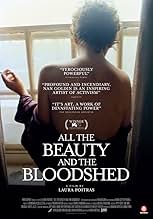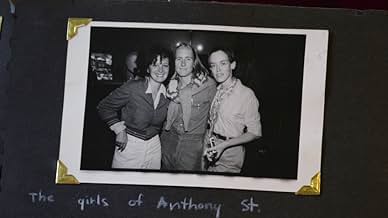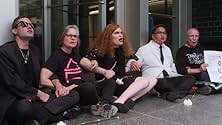IMDb रेटिंग
7.5/10
8.8 हज़ार
आपकी रेटिंग
कलाकार नान गोल्डिन के जीवन और सैकलर परिवार के पतन के बाद, फार्मास्युटिकल राजवंश जो ओपिओइड महामारी की अथाह मौत के लिए बहुत ज़िम्मेदार था.कलाकार नान गोल्डिन के जीवन और सैकलर परिवार के पतन के बाद, फार्मास्युटिकल राजवंश जो ओपिओइड महामारी की अथाह मौत के लिए बहुत ज़िम्मेदार था.कलाकार नान गोल्डिन के जीवन और सैकलर परिवार के पतन के बाद, फार्मास्युटिकल राजवंश जो ओपिओइड महामारी की अथाह मौत के लिए बहुत ज़िम्मेदार था.
- 1 ऑस्कर के लिए नामांकित
- 36 जीत और कुल 57 नामांकन
Robert Drain
- Self - Judge
- (as Judge Robert Drain)
David Armstrong
- Self - Photographer and Friend of Nan
- (आर्काइव फ़ूटेज)
Bruce Balboni
- Self - Actor
- (आर्काइव फ़ूटेज)
फ़ीचर्ड समीक्षाएं
There's a family who had legalised addiction, who pushed their products to administer more affliction, once you're trapped it's hard to leave, there's a good chance that you'll grieve, if you know someone, they'll need more than benediction.
A wonderful piece of factual storytelling focused around Nan Goldin's pursuit of justice and recompense for those helplessly hooked on Oxycontin, a drug that was peddled without remorse by people who thought they were above the law. The film also explores in some detail the life of Nan, her career as an artist, the wild and colourful characters she got to know in NYC, and the often crazy things she found herself doing, as well as her life as a child and the sister she lost.
A wonderful piece of factual storytelling focused around Nan Goldin's pursuit of justice and recompense for those helplessly hooked on Oxycontin, a drug that was peddled without remorse by people who thought they were above the law. The film also explores in some detail the life of Nan, her career as an artist, the wild and colourful characters she got to know in NYC, and the often crazy things she found herself doing, as well as her life as a child and the sister she lost.
I read the review by CinemaSerf and had similar reaction: I had expected much more of an exposé of the Sacklers. The documentary assumed that viewers would just take the side of the protesters against Sackler, but anyone with an enquiring mind might just wonder what the evidence was. I was in the fortunate position of having read Empire of Pain by Patrick Radden Keefe, which does a thorough and gripping account of the origins of the Sackler family and all their dodgy dealings, pushing opioid drugs to physicians, and recommending alarmingly high doses while arguing that only certain types of people got addicted. Once you have that background, any doubts about Nan Goldin's activism are dispelled, and you look in awe at what she's done. In effect, this film, which is quirky and relies mainly on vision and sound rather than words to convey messages, complements the scholarly verbal account in Empire of Pain. The Sackler story is only part of it - it sits in the context of Nan Goldin's remarkable life and career as photographer documenting the underground life of unconventional people after she escaped her dysfunctional family. It's an important film documenting an era in history, and showing how individuals can take on the rich and powerful. Nan features in Patrick Radden Keefe's book, and he features in her film, but I think that if you put the two together, it's perfect and the whole is greater than the parts.
All the Beauty and the Bloodshed can join Fire of Love in the club of Oscar-nominated documentaries from 2022 that would have been more worthy winners than Navalny. It's admittedly a small club, but I feel like both of those movies have moments that demonstrate documentary filmmaking at its best.
In the case of All the Beauty and the Bloodshed, it's probably the final 15-20 minutes that shines the brightest. It can be a slow and somewhat uneven feeling documentary at some points, but it builds to some phenomenal and emotionally hard hitting final scenes. The rest of the documentary still tends to hit far more often than it misses, but I did get the sense it may have been a tiny bit too long, and while I respect the choice not to tie together its two primary narratives more explicitly, part of me was waiting for them to collide more directly at a point. Still, leaving some of that up to the viewer felt like a deliberate choice, and I can respect that.
It follows Nan Goldin, with the film both recounting her life story from the 1950s to the 1990s and detailing her activism against the Sackler family and their role in the opioid epidemic in the 2010s. The latter might be more interesting narratively, but the former has the more interesting presentation, seeing as Goldin's an accomplished artist/photographer, and the documentary frequently relies on her work to serve as visuals.
It's a heavy and often sad documentary, dealing with mental illness, addiction, corruption, censorship, the AIDS crisis, discrimination, and domestic violence. It might be upsetting to some viewers as a result, but I think it was best not to pull punches (so long as people know what they're in for before deciding to watch it). It's a largely powerful documentary that I think will stick with me. Not perfect, but it has some amazing sequences that were very striking and moving.
In the case of All the Beauty and the Bloodshed, it's probably the final 15-20 minutes that shines the brightest. It can be a slow and somewhat uneven feeling documentary at some points, but it builds to some phenomenal and emotionally hard hitting final scenes. The rest of the documentary still tends to hit far more often than it misses, but I did get the sense it may have been a tiny bit too long, and while I respect the choice not to tie together its two primary narratives more explicitly, part of me was waiting for them to collide more directly at a point. Still, leaving some of that up to the viewer felt like a deliberate choice, and I can respect that.
It follows Nan Goldin, with the film both recounting her life story from the 1950s to the 1990s and detailing her activism against the Sackler family and their role in the opioid epidemic in the 2010s. The latter might be more interesting narratively, but the former has the more interesting presentation, seeing as Goldin's an accomplished artist/photographer, and the documentary frequently relies on her work to serve as visuals.
It's a heavy and often sad documentary, dealing with mental illness, addiction, corruption, censorship, the AIDS crisis, discrimination, and domestic violence. It might be upsetting to some viewers as a result, but I think it was best not to pull punches (so long as people know what they're in for before deciding to watch it). It's a largely powerful documentary that I think will stick with me. Not perfect, but it has some amazing sequences that were very striking and moving.
This documentary about Nan Goldin and her battles throughout her life--personally and professionally--is many pronged with New York as the background. She was part of the art movement in the 1980's when AIDS started to invade that scene unabated since the administration of the time felt it was only a gay disease and would not be addressed. Her anger could have been surmised as the beginning there, but then we got a glimpse of her life growing up with the poor treatment her sister got by her parents. Things progressed from there. Her activism developed in the 1980's and continued into the age of Purdue Pharmacy's creation and rampant spread of oxycodone. The documentary may seem to be a bit of a hodgepodge of memories, but when you understand that her anger was developing almost from the moment she was born, you can understand how heartfelt her concern was for those who died around her. This was nominated as Best Feature Documentary for the Oscars It is an uncomfortable yet quite informative watch.
Another important story to tell but the film itself is lacking some of that connection I'm expecting to feel.
The choice to weave Nan's personal, artistic and activism journey all together is an interesting but risky one because it weakens the delivery on either one of them.
Personally, it feels like the film is putting Nan on a pedestal, instead of where she was most of her life, the dark, dirty and forgotten edges of the city. As a result, her on screen persona sometimes feels even more out of touch than a fictional character.
For what it's worth, the film comes back to the title in the end where it ties All The Beauty And The Bloodshed that Nan has seen throughout her whole life with who she is and what she is trying to achieve now. But it's just a little bit too late for my liking.
The choice to weave Nan's personal, artistic and activism journey all together is an interesting but risky one because it weakens the delivery on either one of them.
Personally, it feels like the film is putting Nan on a pedestal, instead of where she was most of her life, the dark, dirty and forgotten edges of the city. As a result, her on screen persona sometimes feels even more out of touch than a fictional character.
For what it's worth, the film comes back to the title in the end where it ties All The Beauty And The Bloodshed that Nan has seen throughout her whole life with who she is and what she is trying to achieve now. But it's just a little bit too late for my liking.
क्या आपको पता है
- ट्रिवियाThe title of the film is a reference to Nan Goldin's older sister, Barbara Holly Goldin. It's a direct quote from a mental health evaluation of Barbara during her time at an institution. She died by suicide in 1965, at the age of 18. This film and Nan Goldin's 1986 "The Ballad of Sexual Dependency" are dedicated to her.
- भाव
Self - Nan's Mother: Droll thing life is -- that mysterious arrangement of merciless logic for a futile purpose. The most you can hope from it is some knowledge of yourself -- that comes too late -- a crop of inextinguishable regrets. Joseph Conrad, Heart of Darkness
- साउंडट्रैकThe Cold Song
Performed by Klaus Nomi
टॉप पसंद
रेटिंग देने के लिए साइन-इन करें और वैयक्तिकृत सुझावों के लिए वॉचलिस्ट करें
- How long is All the Beauty and the Bloodshed?Alexa द्वारा संचालित
विवरण
- रिलीज़ की तारीख़
- कंट्री ऑफ़ ओरिजिन
- आधिकारिक साइटें
- भाषा
- इस रूप में भी जाना जाता है
- Hayatın Tüm Acıları ve Güzellikleri
- फ़िल्माने की जगहें
- न्यूयॉर्क शहर, न्यूयॉर्क, संयुक्त राज्य अमेरिका(Metropolitan Art Museum protest)
- उत्पादन कंपनियां
- IMDbPro पर और कंपनी क्रेडिट देखें
बॉक्स ऑफ़िस
- US और कनाडा में सकल
- $5,00,082
- US और कनाडा में पहले सप्ताह में कुल कमाई
- $28,803
- 27 नव॰ 2022
- दुनिया भर में सकल
- $14,83,975
- चलने की अवधि1 घंटा 53 मिनट
- रंग
- ध्वनि मिश्रण
- पक्ष अनुपात
- 1.78 : 1
इस पेज में योगदान दें
किसी बदलाव का सुझाव दें या अनुपलब्ध कॉन्टेंट जोड़ें









































